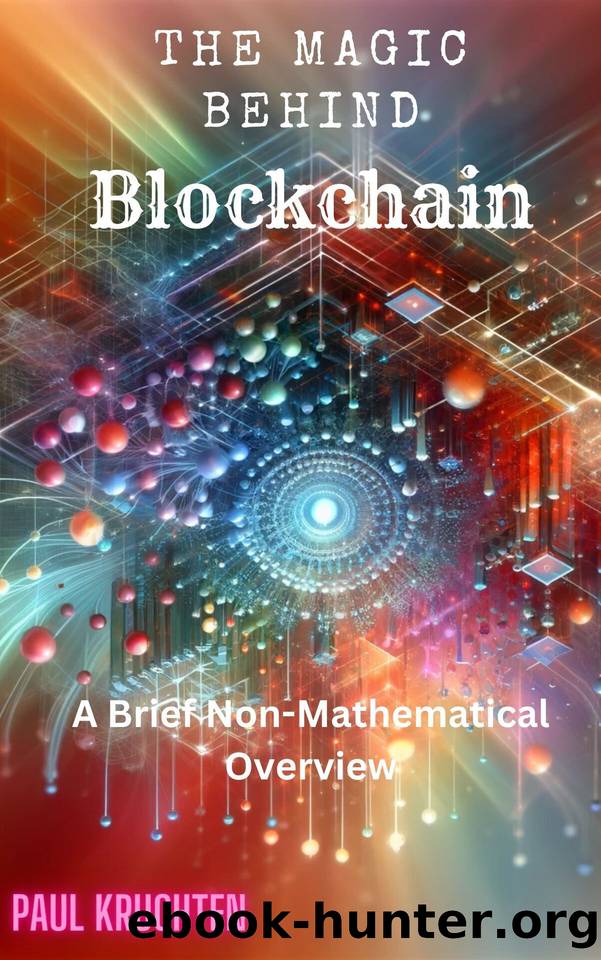The Magic Behind Blockchain: A Brief Non-Mathematical Overview by kruchten paul

Author:kruchten, paul
Language: eng
Format: epub
Published: 2024-01-06T00:00:00+00:00
Beschastnikh, I., Zhou, M., Han, Y., Zeng, L., Li, P., Long, F., Zhou, D., & Wu, M. (2023, May 18). MERCURY: Fast Transaction Broadcast in High Performance Blockchain Systems2.
Leung, V., Lang, P., Tian, D., Duan, X., Zhou, J., & Sheng, Z. (2023, April 28). Blockchain-Based Cooperative Computation Offloading and Secure Handover in Vehicular Edge Computing Networks2.
Aldoubaee, A., Hassan, N. H., & Rahim, F. A. (2023). A systematic review on blockchain scalability
6. **Cryptography:**
The use of cryptographic techniques for securing transactions and controlling the creation of new units. This includes hash functions and public-private key encryption.
In the sophisticated realm of blockchain technology, cryptography is not merely a tool; it is the very fabric that weaves together the security, integrity, and trust that are quintessential to blockchain networks. This utilization of cryptography is far from rudimentary; it is a nuanced and intricate application of complex mathematical principles that underpin the operation and reliability of blockchain systems.
At the heart of blockchain cryptography lies the use of cryptographic hash functions, such as SHA-256 in Bitcoin. These functions take input data of any size and produce a fixed-size hash, a unique digital fingerprint of the input data. Hash functions are deterministic, meaning the same input will always produce the same output, but they are designed to be one-way and collision-resistant. This means that it's infeasible to reverse-engineer the input from its hash output, and it's incredibly unlikely for two different inputs to produce the same hash. In blockchain, every block contains the hash of its predecessor, creating a chain of blocks. This hash-based linking is what makes the blockchain immutable; any attempt to alter a transaction would require recalculating the hashes of all subsequent blocks, a computationally prohibitive task in a large network.
Public key cryptography, another cornerstone of blockchain technology, enables secure, private transactions and is the basis for digital signatures. Each user has a pair of cryptographic keys: a public key, which is openly shared, and a private key, which is kept secret. The public key can be used to encrypt data that only the corresponding private key can decrypt, enabling secure communication. In the context of blockchain, digital signatures are used to verify the authenticity of transactions. A user signs a transaction with their private key, and other network participants use the corresponding public key to verify that the transaction was indeed created by that user, ensuring non-repudiation and integrity.
The intersection of blockchain with advanced cryptographic techniques like Zero-Knowledge Proofs (ZKPs) further expands its capabilities. ZKPs allow one party to prove to another that a statement is true without revealing any information beyond the validity of the statement itself. This has significant implications for privacy in blockchain transactions, enabling users to verify transactions without disclosing sensitive information.
However, the cryptographic landscape is not without its challenges. The advent of quantum computing presents potential risks to current cryptographic standards. Quantum computers could theoretically break widely used cryptographic algorithms, posing a future threat to blockchain security. This has spurred research into quantum-resistant cryptography, seeking to develop new algorithms that could withstand quantum attacks.
Download
This site does not store any files on its server. We only index and link to content provided by other sites. Please contact the content providers to delete copyright contents if any and email us, we'll remove relevant links or contents immediately.
Introduction to Enterprise Service Management by InvGate Inc & Ariel Gesto(613)
The Magic Behind Blockchain: A Brief Non-Mathematical Overview by kruchten paul(220)
Out of the Inner Circle: The True Story of a Computer Intruder Capable of Cracking the Nation's Most Secure Computer Systems by Bill Landreth(218)
The Software Engineer's Guidebook: Navigating senior, tech lead, and staff engineer positions at tech companies and startups by Gergely Orosz(200)
Top AI Tools That Changed the Game in Digital Marketing by Saravanan Clinton(198)
Patterns of Software Construction by Stephen Rylander(197)
Creating Agile Organizations: A Systemic Approach by Ilia Pavlichenko & Cesario Ramos(190)
The Legend of Final Fantasy X by Damien Mecheri;(167)
Artificial Intelligence in Byte-sized Chunks by Peter J. Bentley(164)
Stakeholder Mapping Deep Dive by Bösenberg Peter(151)
Lean DevOps: A Practical Guide to On Demand Service Delivery by Robert Benefield(150)
The Offi cial Guide to Mermaid.js by Knut Sveidqvist Ashish Jain(147)
Mastering REST APIs by Sivaraj Selvaraj(142)
JIRA 5.2 Essentials by Unknown(132)
The Engineering Leader by Cate Huston(125)
Embedding Artificial Intelligence into ERP Software by Unknown(124)
Agile From First Principles by Girvan Lynda;Girvan Simon; & Simon Girvan(117)
Business Writing for Technical People by Marshall Carrie;(117)
Introduction to Computers: A detailed guide to Computer Applications by Banik Biswajit(110)
